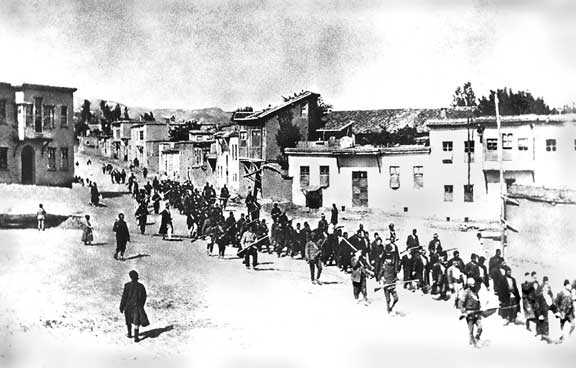Before the Holocaust
For hundreds of years, people have been persecuted and murdered because of their identity. This background knowledge is essential to understanding how the legal concept of ‘genocide’ was developed.

Image: Armenians being marched by Turkish soldiers
The Holocaust shook the foundations of civilisation. It prompted a significant international coordinated response and was the first situation to be legally defined as a genocide.
However, although ‘genocide’ did not exist as a legal term before the Holocaust, the crime of attempting to destroy a group of people based on their identity had certainly been committed before. The UN Genocide Convention recognises that ‘at all periods of history genocide has inflicted great losses on humanity’.
Evidence of people being persecuted because of their identity stretches back thousands of years. Examples include the expulsion of the Jews from Spain in 1492, the murder of Native Americans during the colonisation of North America over centuries, atrocities committed against Congolese people in the late 19th century, and, more recently, atrocities committed against Armenians in the early 20th century.
The legal term ‘genocide’
Genocide is not necessarily more or less serious than other crimes in which large numbers of people are persecuted or murdered, such as crimes against humanity or war crimes, but it is a specific term which does not apply to all atrocities.
Genocide is a complex legal term, and without a trial in an international criminal court, it is difficult to say for certain what would and would not fit within the legal definition retrospectively.
The term genocide was coined by Raphael Lemkin, and has been used to recognise the actions of a state-sponsored attempt to destroy a particular group of its people since 1946. It was, in part, developed by Lemkin in response to atrocities committed against Armenians between 1915 and 1923.
Holocaust Memorial Day was established to commemorate the Holocaust, and to reflect on genocides that have taken place subsequently that demonstrate humanity’s failure to learn the lessons of the Holocaust. This is why we commemorate genocides which have taken place since the Holocaust.
Atrocities against the Armenians and the development of the term ‘genocide’
Between 1915 and 1923, the Armenian population of the Ottoman Empire were systematically persecuted, deported from their homes and murdered. Following the Balkan Wars and start of the First World War, Armenian men, women and children were expelled and exterminated in an attempt to destroy their very existence. The campaign was waged against Armenians following a period of deterioration in relations between ethnic groups in the Empire and a number of political and financial upheavals.
It is unknown exactly how many Armenians were murdered in this period but estimates range from 1.3 million to 1.9 million. Raphael Lemkin was so motivated by the lack of recognition and awareness of the crimes in Armenia that in 1933 he presented a paper to the League of Nations about the Crime of barbarity. The paper outlined a way in which the International Community could condemn the crimes and atrocities in the Ottoman Empire, and provided a basis to prosecute the perpetrators behind such crimes. This later evolved into the crime of genocide, with the term being recognised by the UN in a convention in 1946.
From 1946 onwards, the term genocide has been used to recognise the actions of a state-sponsored attempt to destroy a particular group of its people.
Find out more:
- Read more about Raphael Lemkin.
- Watch the Untold Story of Astrid Aghajanian, whose mother saved her from murder in Armenia by hiding beneath the bodies of those who had already been killed.